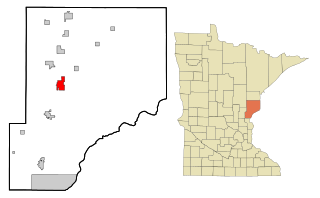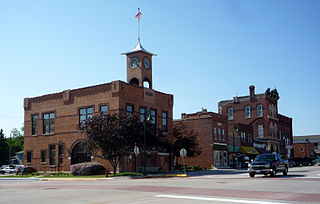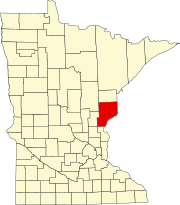Related Research Articles

Pine County is a county in the U.S. state of Minnesota. As of the 2020 census, the population was 28,876. Its county seat is Pine City. The county was formed in 1856 and organized in 1872.

Pine River is a city in Cass County, Minnesota, United States. The population was 944 at the 2010 census. It is part of the Brainerd Micropolitan Statistical Area.

Askov is a city in Pine County, Minnesota, United States. The population was 364 at the 2010 census.

Bruno is a city in Pine County, Minnesota, United States. The population was 102 at the 2010 census.

Denham is a city in Pine County, Minnesota, United States. The population was 35 at the 2010 census.

Kerrick is a city in Pine County, Minnesota, United States. The population was 65 at the 2010 census.

Sandstone is a town in Pine County, Minnesota, United States, along the Kettle River. The population was 2,849 at the 2010 census.

Sturgeon Lake is a city in Pine County, Minnesota, United States. The population was 439 at the 2010 census.

Pine Island is a small city of about 3,500 residents in Goodhue and Olmsted counties in the U.S. state of Minnesota. Most of Pine Island is in Goodhue County, but a small part extends into Olmsted County, making that portion part of the Rochester metropolitan area.
The Grindstone River is a 6.7-mile-long (10.8 km) river of Minnesota, a tributary of the Kettle River. Its name is derived either from the Dakota Iŋswú watpá or from the Ojibwe Zhiigwanaabikokaa-ziibi. Sandstone taken from near the river was used to produce sharpening stones. In Ojibwe, Hinckley (Gaa-zhiigwanaabikokaag) is named after this river.
The Net River is a 24.5-mile-long (39.4 km) tributary of the South Fork Nemadji River in Pine and Carlton counties, Minnesota, United States. Via the Nemadji River, it flows to Lake Superior at Superior, Wisconsin.
The Pine River is a 23.0-mile-long (37.0 km) tributary of the Kettle River in eastern Minnesota, United States. It begins at the outlet of Big Pine Lake near the western border of Pine County, Minnesota, and flows northeast and east, reaching the Kettle River at Rutledge.
The Pine River is a 56.9-mile-long (91.6 km) tributary of the Mississippi River in northern Minnesota, United States.
Corona is an unincorporated community in Carlton County, in the U.S. state of Minnesota. Corona is located at 46°40′14″N92°45′59″W.
Pine Lake may refer to two separate lakes in Chisago County, Minnesota
Belden is a ghost town in Pine County, in the U.S. state of Minnesota.
Harlis is a ghost town in Pine County, in the U.S. state of Minnesota.
Locust Grove is an unincorporated community in Boston Township, Wayne County, in the U.S. state of Indiana.
Paultown is an unincorporated community in eastern Adair County, in the U.S. state of Missouri. The community was approximately one mile northeast of Brashear and the Paultown Cemetery is about one-half mile to the east above Big Deer Branch.
Sticklerville is an unincorporated community in Sullivan County, in the U.S. state of Missouri.
References
- ↑ U.S. Geological Survey Geographic Names Information System: Banning, Minnesota
- ↑ "Pine County". Jim Forte Postal History. Retrieved 30 July 2015.
- ↑ Upham, Warren (1920). Minnesota Geographic Names: Their Origin and Historic Significance. Minnesota Historical Society. p. 410.
- ↑ United States Census Bureau. "Census of Population and Housing".
Coordinates: 46°09′38″N92°51′07″W / 46.16056°N 92.85194°W
